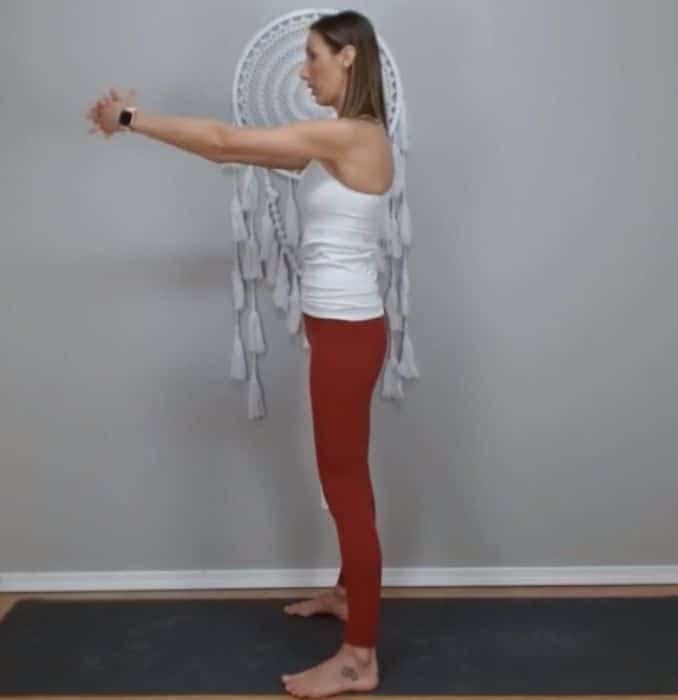Preparing your body before hitting the golf course is akin to giving it a friendly wake-up call. For golfers, great golf warm-up exercises are like a sneak peek at your muscles, enhancing blood flow and rendering them more flexible, ensuring you can easily swing the club. Beyond the immediate benefits, warming up is a proactive measure in playing golf to prevent injuries.
Additionally, it positively impacts your focus and coordination, which are crucial for aiming for the perfect shot, especially during the critical first few holes. A thorough warm-up is the secret sauce for a smoother and more enjoyable golf game, a practice recognized and valued by many golfers.
Benefits of Warm-Up Exercises
This systematic review by Alex Ehlert and Patrick B. Wilson examines warm-up routines in golf, focusing on their impact on performance and injury prevention.1 The study analyzed twenty-three research pieces, revealing that many golfers skip warm-ups or do them briefly. While the link between golf warm-up practices and injury rates in golf remains unclear, various warm-up strategies, particularly dynamic exercises and resistance training, have shown potential benefits for golf performance.
In contrast, static stretching might be less effective and could hinder performance. Despite the potential advantages of proper warm-ups, the research indicates that golfers do not regularly practice them.
1. Improved Flexibility

A comprehensive pre-round warm-up routine, combining static stretching, dynamic stretches, and attention to golf swing technique, is pivotal for enhancing flexibility in muscles and joints. These golf warm-up exercises ensure a smoother and more fluid swing, allowing golfers to approach the first tee and the initial holes confidently and precisely.
2. Enhanced Blood Flow
The warm-up sequence, which includes dynamic stretches and practice swings, promotes increased blood circulation. This surge in blood flow delivers vital oxygen to muscles, optimizing their performance during the game. With improved blood flow, golfers experience heightened endurance, making navigating the course easier and maintaining energy levels throughout the round.
3. Reduced Injury Risk

Incorporating static stretching and dynamic exercises into a good warm-up routine effectively reduces the risk of injury. By preparing the body for the physical demands of golf, golfers can minimize the chances of muscle strains or injuries during play. This preventative approach, encompassing traditional stretching methods, contributes to a safer and more sustainable golfing experience.
4. Better Performance
The positive impact of a thorough warm-up, including attention to golf swing technique, directly translates to improved on-course performance. With warmed-up muscles, golfers can execute swings precisely and confidently, playing at their best.
5. Efficient Coordination
Dynamic stretches and a focus on golf swing technique during the warm-up enhance muscle coordination. As golfers step onto the first tee, the benefits of the warm-up routine become evident in controlled and accurate swings, setting the tone for a successful round.
6. Quicker Recovery

A well-designed warm-up routine, encompassing dynamic stretches and traditional stretching methods, primes the body for activity, leading to a faster recovery post-game. Elevating body temperature and activating muscles contribute to an efficient recovery process, minimizing muscle soreness and fatigue.
7. Enjoyable Experience
Incorporating pre-round warm-ups, including static stretching, dynamic stretches, and attention to golf swing technique, creates the foundation for a positive and fulfilling game. Whether you're a seasoned golfer or a casual enthusiast, recognizing the importance of a good warm-up routine enhances your physical preparedness and overall enjoyment of the sport.
Swing Smart, Play Safe: Unveiling the Power of Warm-Up in Golf Injury Prevention
- Golf-related Back Strains: Golf twisting and swinging can strain the back, leading to potential injuries. Incorporate gentle torso rotations and back stretches in your warm-up to prepare muscles for the game's rotational demands.
- Shoulder Injuries in Golf: Overuse or improper swing mechanics may cause shoulder problems in golfers. Enhance flexibility and reduce the risk of strain by starting your warm-up with arm circles and shoulder stretches, part of a comprehensive golf warm-up exercise routine.
- Elbow Tendonitis Caution: Repetitive swinging in golf can lead to elbow tendon inflammation. Prioritize wrist and forearm stretches in your warm-up to foster flexibility and alleviate stress on the elbow joints.
- Knee Strains in Golf: Pivoting during the golf swing can stress knee joints, potentially causing discomfort or injury. To enhance knee stability and minimize strain, include knee rotations and gentle squats in your warm-up routine.
- Wrist Injury Awareness: Impact on the ball or ground can strain wrists in golf. Prioritizing wrist stretches and rotations in your warm-up can boost joint flexibility and reduce the risk of wrist injuries.
- Muscle Pulls Caution: Cold muscles are more prone to pulls during forceful golf swings. Mitigate the risk with a comprehensive warm-up, including full-body stretches and light aerobic activity to increase overall body temperature and flexibility, incorporating golf warm-up exercises for optimal performance.
- Dehydration Risks in Golf: Playing golf in the sun can lead to dehydration and fatigue. Improve stamina by staying hydrated before and during the game, and incorporate light cardio exercises into your warm-up.
- Ankle Sprains Caution: Uneven terrain on golf courses can cause ankle sprains. Integrating ankle circles and mobility exercises into your warm-up can strengthen ankle joints and decrease the likelihood of sprains.
Warm-Ups
1. Cross-Body Stretch
Begin in an upright standing position with your feet shoulder-width apart, maintaining good alignment with your head, shoulders, hips, and legs. Contract your core. Cross one arm over your chest, then use your other hand to pull your elbow closer to your body while turning your head in the opposite direction. Hold this position for several deep belly breaths, in through your nose and out through your mouth. Relax and repeat the movement on the opposite side.
To intensify the exercise, open and close your fist for 5 repetitions.
 |
 |
2. Upper Back Stretch
Begin in an upright standing position with your feet shoulder-width apart, maintaining good alignment with your head, shoulders, hips, and legs. Engage your core. Interlace your fingers and extend your arms in front of your body. Pull your arms forward as you drop your chin down towards your chest, rounding out your midback. Hold this position for several deep belly breaths, in through your nose and out through your mouth.
To intensify this exercise, move your arms upward and downward.
 |
 |
Routines
1. Supported Chest Stretch
For this exercise, utilize a golf club or any long stick you can hold behind your back for added support.
Begin in an upright standing position with your feet shoulder-width apart, maintaining good alignment with your head, shoulders, hips, and legs. Engage your core. Hold the golf club behind your back with your arms shoulder-width apart. Looking for a light stretch in front of your chest, engage your core and lift your joined hands away from your body. Hold this position for several deep belly breaths, through your nose and out through your mouth. Relax and return to the starting position.
To intensify this exercise, hinge forward and move your upper body from side to side.

2. Supported Side Bend
For this exercise, utilize a golf club or any long stick you can hold for added support.
Begin in an upright standing position with your feet wider than shoulder-width apart, maintaining good alignment with your head, shoulders, hips, and legs. Extend your arms widely in front of your body, holding the golf club in both hands. Engage your core and bend your upper body to the side, lifting one end of the golf club towards the ceiling as you bring your gaze upward. Hold this position for several deep belly breaths through your nose and out through your mouth. Return to the starting position and repeat the movement on the opposite side.
 |
 |
To intensify this exercise, hinge through your hips to bend your upper body forward and twist your upper body to one side. Lower one end of the golf club to the floor, keeping the club aligned. Hold this position for a couple of seconds. Return to the starting position and repeat the movement on the opposite side.
 |
 |
3. Supported Quad Stretch
For this exercise, utilize a golf club or any long stick for support and balance.
Begin in an upright standing position with your feet shoulder-width apart, maintaining good alignment with your head, shoulders, hips, and legs. Position the golf club in front of your body and hold onto the top of the handle with one hand for stability and balance. Engage your core. Shift your weight onto one leg and bring one heel up against your seat, holding your foot with your other hand. Hold this position for several deep belly breaths, through your nose and out through your mouth. Return to the starting position and repeat the movement on the opposite side.
 |
 |
4. Supported Lunge
For this exercise, utilize a golf club or any long stick for support and balance.
Begin in an upright standing position, maintaining good alignment with your head, shoulders, hips, and legs. Engage your core. Position the golf club in front of your body and hold onto the top of the handle with one hand for stability and balance. Engage your core. Take a big step back with one foot and bend your front knee directly over your ankle. Straighten your back leg as you stack your heel over your toes, shifting your pelvis and pressing through your back toes. Hold this position for several deep belly breaths, through your nose and out through your mouth. Return to the starting position and repeat the movement on the opposite side.

Conclusion

Incorporating warm-up exercises into your golf routine is a game-changer. It primes your body for optimal performance, reducing the risk of injuries and enhancing your overall experience in the game. Consistency is the secret sauce– make it a habit, and your body will thank you with improved flexibility, focus, and game-day skill. Whether you are a professional or a weekend warrior, investing a few minutes in a thoughtful warm-up pays off in smoother swings, better shots, and a more enjoyable time on the golf course. So, before you start, take the time to warm up– you will enhance your game and safeguard your body for many rounds to come.
Ready to elevate your game? Start your next round of golf on the right foot by incorporating warm-up exercises into your pre-game routine. Check out our 11 Daily Stretches to Feel and Look Amazing.





